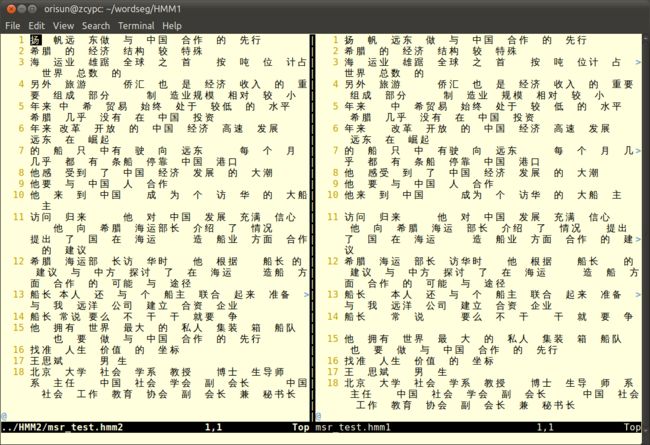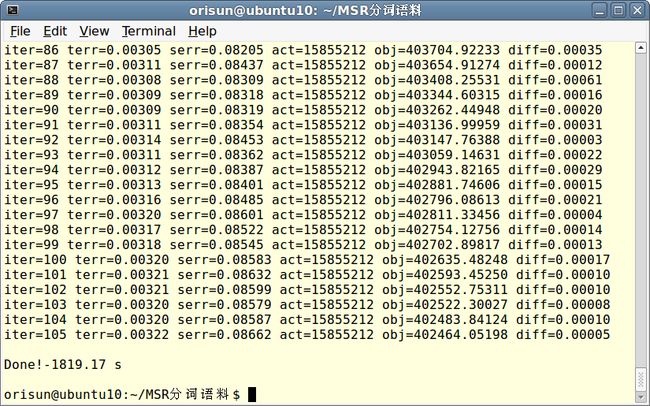模型的建立
一句话中出现的汉字构成观察序列,如“希腊的经济结构较特殊”对应的观察序列O={希,腊,的,经,济,结,构,较,特,殊}。所有观察值的集合至少应该包含训练集和测试集中出现的所有汉字。
状态有4种:B表示词首的汉字;M表示词语中间的汉字;E表示词尾的汉字;S表示单独的汉字构成一个词。
举例:希/B腊/E 的/S 经/B济/M结/M构/E 较/S 特/B殊/E
文本的预处理
语料库用的是使用msr_training.utf8和msr_test.utf8
由于要做分词,我们的观察值是一个一个的汉字,从文本中提前汉字的方法自然是一次读取3个字节。如果文本中含有英文符号、英文字母、阿拉伯数字等对会对提取汉字的工作造成干扰。有一种去除单字节编码字符的方法是:先利用ICTCLAS进行分词和词性标注(wordseg.cpp),然后去除词性以下列字母开关的词(posfilter.cpp):
m:数词,里面通常包含数字
x:字符串,包含英文字母
w:标点符号,可能包含英文标点符号
t:时间,可能包含数字
另外词性为nrf(音译人名,如“阿沛·阿旺晋美”)的词也应该去掉,因为包含一个点。
wordseg.cpp
#include
#include
#define OS_LINUX
#include "ICTCLAS50.h"
using namespace std;
int main(int argc, char *argv[])
{
if (argc < 2) { //命令行中需要给定要处理的文件名
cout << "Usage:command filename" << endl;
return 1;
}
string filename = argv[1];
string outfile = filename + ".ws";
string initPath = "/home/orisun/master/ICTCLAS50_Linux_RHAS_32_C/API";
if (!ICTCLAS_Init(initPath.c_str())) {
cout << "Init fails" << endl;
return -1;
}
ICTCLAS_FileProcess(filename.c_str(), outfile.c_str(), CODE_TYPE_UTF8,1);
ICTCLAS_Exit();
return 0;
} posfilter.cpp
#include
#include
#include
#include
#include
using namespace std;
int main(int argc,char *argv[]){
set filter_set;
filter_set.insert('m');
filter_set.insert('x');
filter_set.insert('w');
filter_set.insert('t');
if(argc<2){
cout<<"usage: "<>word){
string::size_type pos=word.find("/");
string post=word.substr(pos+1);
char c=post.at(0);
if(c=='w')
line_out+=" ";
if(filter_set.find(c)==filter_set.end() && post!="nrf"){ //词性不在被过滤的集合当中
line_out+=word.substr(0,pos); //对于训练集要追加空格,对测试集不能追加空格
}
}
ofs< 另外由于ICTCKLAS词性标注也不是100%准确,采用上述方法并不能将单字节编码的字符去除干净,在BMES.cpp中会进行最后的检查,找到单字节字符后再手动将其删除即可。
最后请在train文档中手动去除℃和/
BMES.cpp
#include
#include
#include
#include
using namespace std;
int main(int argc,char *argv[]){
if(argc<3){
cout<<"Usage: "<>word){
if(word.size()%3!=0){
cout< 同样要把train文本和test文本中的所有汉字录入GDBM数据库中,然后对所有汉字标记序号。
train2dict.cpp
#include
#include
#include
#include
#include
#include
#define DB_FILE_BLOCK "dict_db"
int main(int argc,char* argv[]){
if(argc<2){
printf("Usage: %s BMES_marked_file.\n",argv[0]);
exit(1);
}
FILE *fp;
if((fp=fopen(argv[1],"r"))==NULL){
perror("fopen");
exit(1);
}
GDBM_FILE dbm_ptr;
dbm_ptr = gdbm_open(DB_FILE_BLOCK,0,GDBM_WRCREAT,S_IRUSR | S_IWUSR,NULL);
char *v="w";
datum key,value;
value.dptr=v;
value.dsize=1;
char word[3]={0};
char *line=NULL; //循环从输入文件中读取一行,放在line中
ssize_t read=0;
size_t needlen=0;
char slash='/';
int line_no=0;
while((read=getline(&line,&needlen,fp))!=-1){
line_no++;
char *begin=line;
char *end=NULL;
while((end=strchr(begin,slash))!=NULL){
if(end-begin<3){
printf("%d:%s\n",line_no,begin);
break;
}
strncpy(word,end-3,3);
key.dptr=word;
key.dsize=3;
//char tmp[4]={0};
//strncpy(tmp,key.dptr,3);
//printf("%s\t",tmp);
gdbm_store(dbm_ptr,key,value,GDBM_REPLACE);
begin=end+2;
}
}
free(line);
fclose(fp);
gdbm_close(dbm_ptr);
return 0;
} test2dict.cpp
#include
#include
#include
#include
#include
#include
#include
#include
#include
using namespace std;
int main(int argc,char* argv[]){
if(argc<2){
cout<<"Usage: "<>str){
if(str.size()%3!=0){
cout<<"size="< indexword.cpp
#include
#include
#include
#include
#include
#include
#define DB_FILE_BLOCK "dict_db"
int main(int argc,char* argv[]){
GDBM_FILE dbm_ptr;
dbm_ptr = gdbm_open(DB_FILE_BLOCK,0,GDBM_WRCREAT,S_IRUSR | S_IWUSR,NULL);
datum key,data;
long index=0; //从0开始编号
char index_str[10]={0};
for(key=gdbm_firstkey(dbm_ptr);key.dptr;key=gdbm_nextkey(dbm_ptr,key)){
data=gdbm_fetch(dbm_ptr,key);
bzero(index_str,sizeof(index_str));
sprintf(index_str,"%ld",index++);
data.dptr=index_str;
data.dsize=sizeof(index_str);
gdbm_store(dbm_ptr,key,data,GDBM_REPLACE);
}
gdbm_close(dbm_ptr);
return 0;
}
我处理好的语料库可以在这里下载:MSR分词语料
二阶HMM中文分词
利用Maxmum Likelihood学习二阶HMM模型参数
AMatrix.cpp
#include
#include
#include
#include
#include
using namespace std;
const int SNUM=4; //SNUM种隐藏状态
const char state[SNUM]={'B','M','E','S'};
int A1[SNUM][SNUM]; //记录一阶Markov状态转移的次数
int A2[SNUM][SNUM][SNUM]; //记录二阶Markov状态转移的次数
int PI[SNUM]; //记录各种状态出现的次数
inline int stateIndex(char state){
switch(state){
case 'B':return 0;
break;
case 'M':return 1;
break;
case 'E':return 2;
break;
case 'S':return 3;
break;
default:return -1;
break;
}
}
//由于隐藏状态只有4种,训练语料足够多,所有可能的状态转移在训练语料中都会出现,所以不使用任何平滑算法
inline void noneturing(const int count[],double prob[],int len){
double total=0.0;
for(int i=0;i gt.h包含Good-Turing平滑算法
#ifndef _HEADER_H
#define _HEADER_H
#include
#include
#include
BMatrix.cpp
#include
#include
#include
#include
#include
#include
#include"gt.h"
#include
#include
const int SNUM = 4;
const int ONUM = 4782; //字典数据库中共有ONUM项
int B1[SNUM][ONUM]; //记录一阶状态发射的次数
int B2[SNUM][SNUM][ONUM]; //记录二阶状态发射的次数
GDBM_FILE dbm_ptr;
inline int stateIndex(char state)
{
switch (state) {
case 'B':
return 0;
break;
case 'M':
return 1;
break;
case 'E':
return 2;
break;
case 'S':
return 3;
break;
default:
return -1;
break;
}
}
inline int observIndex(string chinese)
{
//cout << chinese << endl;
datum key, value;
key.dptr = const_cast < char *>(chinese.c_str());
key.dsize = 3;
value = gdbm_fetch(dbm_ptr, key);
int index = atoi(value.dptr);
return index;
}
int main(int argc, char *argv[])
{
if (argc < 2) {
cout << "usage: " << argv[0] << " inputfile" << endl;
return 1;
}
ifstream ifs(argv[1]);
if (!ifs) {
cerr << "open file " << argv[1] << " failed." << endl;
return 1;
}
dbm_ptr = gdbm_open("dict_db", 0, GDBM_READER, S_IRUSR | S_IWUSR, NULL);
string line;
//int line_no = 1;
while (getline(ifs, line)) {
//cout << line_no++ << endl;
string::size_type local;
if ((local = line.find("/")) != string::npos) {
char s = line.at(local + 1); //第1个状态
string chinese = line.substr(local - 3, 3); //第1个观察值
int j = stateIndex(s);
int k = observIndex(chinese);
B1[j][k]++;
int i;
while ((local =
line.find("/", local + 1)) != string::npos) {
s = line.at(local + 1); //下1个状态
chinese = line.substr(local - 3, 3); //下1个观测值
i = j;
j = stateIndex(s);
k = observIndex(chinese);
B1[j][k]++;
B2[i][j][k]++;
}
}
}
ifs.close();
gdbm_close(dbm_ptr);
ofstream ofs1("B1.mat");
ofstream ofs2("B2.mat");
if (!(ofs1 && ofs2)) {
cerr << "create outputfile failed." << endl;
return 1;
}
ofs1 << setprecision(8);
ofs2 << setprecision(8);
double arr[ONUM] = { 0.0 };
for (int i = 0; i < SNUM; ++i) {
goodturing(B1[i], arr, ONUM);
for (int j = 0; j < ONUM; ++j)
ofs1 << arr[j] << "\t";
ofs1 << endl;
}
for (int i = 0; i < SNUM; ++i) {
for (int j = 0; j < SNUM; ++j) {
goodturing(B2[i][j], arr, ONUM);
for (int k = 0; k < ONUM; ++k)
ofs2 << arr[k] << "\t";
ofs2 << endl;
}
}
ofs1.close();
ofs2.close();
return 0;
}
Viterbi算法进行分词
#include
#include
#include
#include
#include
#include
#include
#include
using namespace std;
const string DB_FILE_BLOCK="dict_db";
GDBM_FILE dbm_ptr;
const int SNUM=4; //隐藏状态集合大小
const int ONUM=4782; //观察值集合大小
/*二阶HMM模型参数*/
double PI[SNUM];
double A1[SNUM][SNUM];
double A2[SNUM][SNUM][SNUM];
double B1[SNUM][ONUM];
double B2[SNUM][SNUM][ONUM];
inline int stateIndex(char state)
{
switch (state) {
case 'B':
return 0;
break;
case 'M':
return 1;
break;
case 'E':
return 2;
break;
case 'S':
return 3;
break;
default:
return -1;
break;
}
}
inline int observIndex(string chinese)
{
//cout << chinese << endl;
datum key, value;
key.dptr = const_cast < char *>(chinese.c_str());
key.dsize = 3;
value = gdbm_fetch(dbm_ptr, key);
int index = atoi(value.dptr);
return index;
}
/*从文件中读出HMM模型参数*/
void initHMM(string f1,string f2,string f3,string f4,string f5){
ifstream ifs1(f1.c_str());
ifstream ifs2(f2.c_str());
ifstream ifs3(f3.c_str());
ifstream ifs4(f4.c_str());
ifstream ifs5(f5.c_str());
if(!(ifs1 && ifs2 && ifs3 && ifs4 && ifs5)){
cerr<<"Open file failed!"<>word;
PI[i]=atof(word.c_str());
}
}else{
cerr<<"Read PI failed!"<>word;
A1[i][j]=atof(word.c_str());
}
}
//读取A2
for(int i=0;i>word;
A2[i][j][k]=atof(word.c_str());
}
}
}
//读取B1
for(int i=0;i>word;
B1[i][j]=atof(word.c_str());
}
}
//读取B2
for(int i=0;i>word;
B2[i][j][k]=atof(word.c_str());
}
}
}
ifs1.close();
ifs2.close();
ifs3.close();
ifs4.close();
ifs5.close();
}
/*Viterbi算法进行分词*/
void viterbi(string sentence,string &result){
if(sentence.size()==0)
return;
result.clear();
int time=sentence.size()/3; //观察序列的长度
if(time<3){ //观测序列中只有1个字或2个字,我们认为这就是1个词
result=sentence.append(" ");
return;
}
double ***Q=new double **[SNUM]; //动态申请并初始化Q和Path数组
int ***Path=new int**[SNUM];
for(int i=0;imax){
max=product;
maxindex=i;
}
}
Q[j][k][t]=max*B2[j][k][ot];
Path[j][k][t]=maxindex;
}
}
}
//找Q矩阵最后一层的最大值
double max=-1.0;
int maxindexi=-1;
int maxindexj=-1;
for(int i=0;imax){
max=Q[i][j][time-2];
maxindexi=i;
maxindexj=j;
}
}
}
//从maxindexj,maxindexi出发,根据Path矩阵找出最可能的状态序列
stack st;
st.push(maxindexj);
st.push(maxindexi);
for(int t=time-3;t>=0;--t){
int maxindexk=Path[maxindexi][maxindexj][t+1];
st.push(maxindexk);
maxindexj=maxindexi;
maxindexi=maxindexk;
}
//释放三维数组
for(int i=0;i
#include
#include
#include
#include
#include
#include
#include
#include
#include
#include
using namespace std;
const string DB_FILE_BLOCK="dict_db";
const int WORDS_NUM=4782;
GDBM_FILE dbm_ptr;
double PI[4]; //初始状态概率矩阵
double A[4][4]; //状态转移矩阵
double B[4][WORDS_NUM]; //发射矩阵
/*从文件中读出HMM模型参数*/
void initHMM(string f1,string f2,string f3){
ifstream ifs1(f1.c_str());
ifstream ifs2(f2.c_str());
ifstream ifs3(f3.c_str());
if(!(ifs1 && ifs2 && ifs3)){
cerr<<"Open file failed!"<>word;
PI[i]=atof(word.c_str());
}
}else{
cerr<<"Read PI failed!"<>word;
A[i][j]=atof(word.c_str());
}
}
//读取B
for(int i=0;i<4;++i){
getline(ifs3,line);
istringstream strstm(line);
string word;
for(int j=0;j>word;
B[i][j]=atof(word.c_str());
}
}
ifs1.close();
ifs2.close();
ifs3.close();
}
/*Viterbi算法进行分词*/
void viterbi(string sentence,string &result){
if(sentence.size()==0)
return;
result.clear();
int row=sentence.size()/3; //观察序列的长度
double **Q=new double*[row]; //初始化Q矩阵
for(int i=0;i(sentence.c_str());
strncpy(chinese,bp,3); //读取句子中的第1个汉字
key.dptr=chinese;
key.dsize=3;
data=gdbm_fetch(dbm_ptr,key); //从数据库中获取汉字对应的index,该index对应发射矩阵的列
int colindex=atoi(data.dptr);
for(int i=0;i<4;++i){
Path[0][i]=-1;
Q[0][i]=PI[i]*B[i][colindex];
}
//给Q和Path矩阵的后续行赋值
for(int i=1;i(sentence.c_str()+i*3);
strncpy(chinese,bp,3); //读取句子中的下一个汉字
key.dptr=chinese;
data=gdbm_fetch(dbm_ptr,key);
colindex=atoi(data.dptr);
for(int j=0;j<4;++j){
double max=-1.0;
int maxindex=-1;
for(int k=0;k<4;++k){
double product=Q[i-1][k]*A[k][j];
if(product>max){
max=product;
maxindex=k;
}
}
Q[i][j]=max*B[j][colindex];
Path[i][j]=maxindex;
}
}
//找Q矩阵最后一行的最大值
double max=-1.0;
int maxindex=-1;
for(int i=0;i<4;++i){
if(Q[row-1][i]>max){
max=Q[row-1][i];
maxindex=i;
}
}
//从maxindex出发,根据Path矩阵找出最可能的状态序列
stack st;
st.push(maxindex);
for(int i=row-1;i>0;--i){
maxindex=Path[i][maxindex];
st.push(maxindex);
}
//释放二维数组
for(int i=0;i
左边是二阶,右边是一阶。目测上去似乎是伯仲之间,至少我们写二阶HMM代码的effort并没有paid off。
为了得到精确的数字,我用SCWS分词系统对msr_test进行了分词,以它的结果作为标准答案(即认为SCWS分词精度为100%),用我的HMM分词结果逐字与之对比BMES标记,HMM一阶的精度为:
总共:153769
出错:38330
正确率:0.750729991090532
二阶HMM的分词精度为:
总共:153769
出错:35372
正确率:0.769966638269092
使用CRF++进行分词
使用的template模板为:
U01:%x[0,0]
U02:%x[-1,0]/%x[0,0]
U03:%x[-2,0]/%x[-1,0]/%x[0,0]
U04:%x[0,0]/%x[1,0]
U05:%x[0,0]/%x[1,0]/%x[2,0]
CRF相比于HMM的便利之处就在于你可以任意的定义特征函数。上面template文件中的U02相当于一阶HMM,U03相当于二阶HMM,而U04和U05则认为一个字的tag跟它后面的字也有关系。
训练中一些参数的说明:
ter:迭代次数
terr:标记错误率
serr:句字错误率
obj:当前对象的值。当这个值收敛到一个确定值的时候,训练完成
diff:与上一个对obj之间的相对差
diff非要减小到0.00000CRF++才肯罢休(第92次迭代的时候已经达到了0.00003),迭代次数到达上限105时它终于退出了。
还是以SCWS的分词结果作为标准,CRF++对msr_test的分词准确率为:
总共:153769
出错:17801
正确率:0.884235
下面的awk代码用于统计CRF++的分词准确率
#!/usr/bin/awk -f
BEGIN{
total=0;
error=0;
}
$0!~/^$/{ #不能是空行
total++;
if($2!=$3){ #第2列和第3列不相同
error++;
}
}
END{
print "总共:" total;
print "出错:" error;
print "正确率:" (1-error/total);
}
